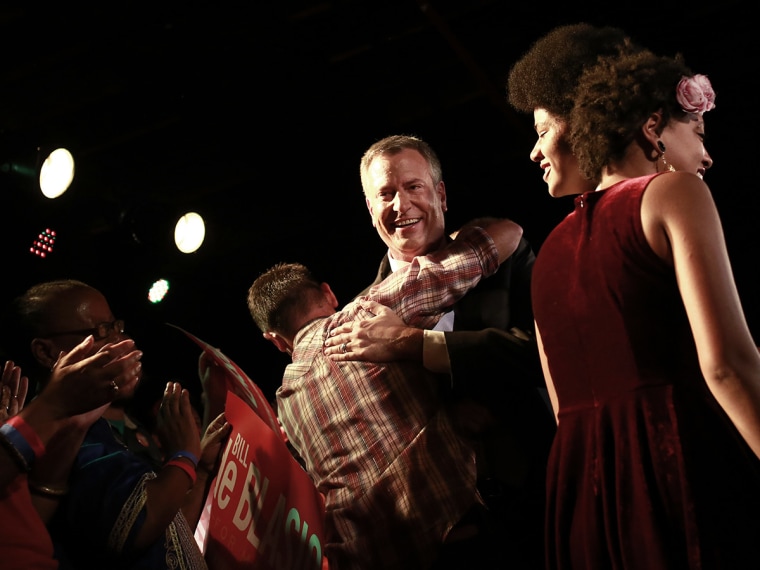If Bill DeBlasio becomes New York City’s next mayor, he won’t just have that viral TV ad showcasing the impressive Afro of his biracial son Dante to thank—though that definitely helped. He’ll also have a less-heralded factor: The city’s groundbreaking system of public financing, which is now being touted as a national model for how to reduce the influence of money in politics in the age of Citizens United.
DeBlasio, currently New York City’s Public Advocate, looks all but certain to be the Democratic nominee for mayor, and he’ll be a strong favorite in November’s general election. He’s reached that position by running a campaign focused squarely on reducing economic inequality, and his most prominent proposal is a plan to raise taxes on those making over half a million dollars to fund early-childhood education.
In other words, DeBlasio isn’t exactly the candidate of Wall Street. The New York Times reported Wednesday that the city’s financial elite, worried about a DeBlasio mayoralty, is rallying around Joe Lhota, the Republican nominee. But barring a major upset, Wall Street isn’t likely to get its way—and the city’s public financing system is a big part of the reason why the influence of the financial industry has been blunted.
New York City’s system has been in place since 1988, but its effect has been obscured in the last three mayoral elections because of Michael Bloomberg’s record-setting campaign spending, made possible by his multi-billion-dollar personal fortune. The system sets a limit of $4,950 on individual contributions. But the key is that it gives candidates an additional six dollars in public money for every dollar they raise from a small donor—defined as anyone giving $175 or less.
That means that for candidates, small donations are worth seven times their actual value. And that in turn encourages candidates to focus their fundraising on small donors, rather than on the 1 percenters who can give the big bucks. That’s exactly what’s happened in New York.
A detailed study by the Brennan Center and the Campaign Finance Institute* found that nearly nine out of ten census blocks in the city contained at least one small donor (that is, someone giving $175 or less) in city council races, which use the public financing system. By contrast, just three in ten census blocks contained a small donor in state legislative races, which don’t use the system. It also found that the neighborhoods where small donors to city council races live have lower incomes and more racial minorities than the neighborhoods where small donors to state legislative races live. The study concluded that the system “gives candidates an incentive to reach out to a broader and more diverse array of constituents to fund their campaigns,” calling the results “remarkable.”
Even more important, the system actually appears to have weakened the power of moneyed interests to get their candidates of choice elected. And it’s not just in the mayor’s race. In a separate analysis shared with MSNBC, the Brennan Center found that the real-estate industry—for years perhaps the most powerful outside force in New York City politics—spent over $2 million in each of seven candidates for city council. Of those candidates, only two won their races.
Supporters of the system would like to see the concept—which has also worked successfully in Los Angeles and Oakland—going national. Susan Lerner, the executive director of Common Cause New York, said her group supports the idea of using public financing as the basis of campaign finance reform for federal elections.
"Public financing of elections is key to any campaign finance reform," Common Cause said last year. "The New York City model has produced more competitive elections, and allowed demographically diverse candidates to win public office despite their resources."
One reason why advocates think that idea might have potential is that, unlike some other recent efforts to reduce the impact of money in politics, New York City’s system has a good shot at withstanding a legal challenge.
In 2011, the Supreme Court struck down a key provision in Arizona’s public financing system that gave additional funds to publicly funded candidates who faced well-financed opponents or heavy outside spending against them. But New York City’s system doesn’t contain those provisions. Instead, it relies entirely on the simple idea of providing matching funds for small donations—a concept that the court had no problem with.
*Correction: This article originally attributed the study to the Brennan Center alone. It was in fact a joint project of the Brennan Center and the Campaign Finance Institute.
